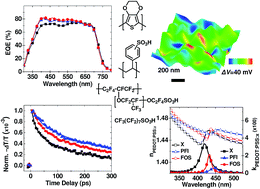Enhanced organic solar cells efficiency through electronic and electro-optic effects resulting from charge transfers in polymer hole transport blends†
Abstract
We demonstrate that blending fluorinated molecules in PEDOT:PSS hole transport layers (HTL) induces charge transfers which impact on both charge extraction and photogeneration within organic photovoltaic (OPV) devices. OPVs fabricated with modified HTL and two photoactive polymer blends led systematically to power conversion efficiencies (PCE) increases, with PTB7:PC70BM blend exhibiting PCE of ∼8.3%, i.e. ∼15% increase compared to pristine HTL devices. A reduced device-to-device characteristics variations was also noticed when fluorinated additives were used to modify the PEDOT:PSS. Shading lights onto the effect of HTL fluorination, we show that the morphology of the polymer:PCBM blends remains surprisingly unaffected by the fluorinated HTL surface energy but that, instead, the OPVs are impacted not only by the HTL electronic properties (work function, dipole layer, open circuit voltage, charge transfer dynamic) but also by alteration of the complex refractive indices (photogeneration, short circuit current density, external quantum efficiencies, electro-optic modelling). Both mechanisms find their origin in fluorination induced charge transfers. This work points towards fluorination as a promising strategy toward combining both external quantum efficiency modulation and power conversion efficiency enhancement in OPVs. Charge transfers could also be used more broadly to tune the optical constants and electric field distribution, as well as to reduce interfacial charge recombinations within OPVs.



 Please wait while we load your content...
Please wait while we load your content...